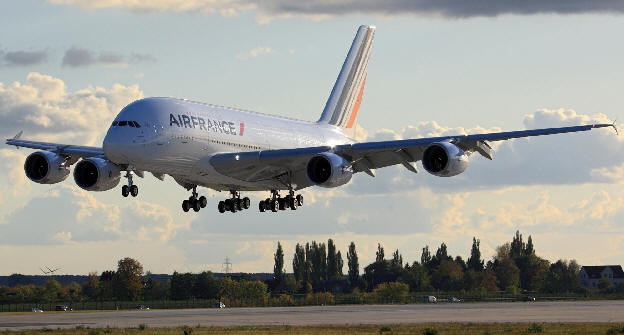
NEWSROOM
 |
NEWSROOM |
|
|
|
||||
|
By Daniel Baxter |
||||
 |
October 31, 2009 -
Based on a decision in 1996, to acquire the A380, Air
Three of the twelve planes on order will be delivered to Air |
|||
|
Air
Its four state-of-the-art GP 7200 engines, its aerodynamic shape and its
fuselage integrating the latest technologies make the A380 the most
environmentally-friendly aircraft of its category. The A380 boasts
equivalent capacity to that of a Boeing 777-200 and an Airbus A340-300
combined, while offering a 20% reduction in operating costs.
Each A380 will enable Air
Air
|
||||
|
As early as 1996, Air
The new Air France A380 is the 20th A380 delivered by Airbus - 10 are
already flying with
The Airbus A380 is a double-deck, wide-body, four-engine airliner
manufactured by the European corporation Airbus, a subsidiary of EADS.
The largest passenger airliner in the world, the A380 made its maiden
flight on 27 April 2005 from
The A380's upper deck extends along the entire length of the fuselage,
and its width is equivalent to that of a widebody aircraft. This allows
for a cabin with 50% more floor space than the next-largest airliner,
the Boeing 747-400, and provides seating for 525 people in a typical
three-class configuration or up to 853 people in all economy class
configurations. The postponed freighter version, the A380-800F, is
offered as one of the largest freight aircraft, with a payload capacity
exceeded only by the Antonov An-225. The A380-800 has a design range of
15,200 km (8,200 nmi), sufficient to fly from
In the summer of 1988, a group of Airbus engineers led by Jean Roeder
began working in secret on the development of a ultra-high-capacity
airliner (UHCA), both to complete its own range of products and to break
the dominance that Boeing had enjoyed in this market segment since the
early 1970s with its 747. McDonnell Douglas unsuccessfully offered its
smaller, double-deck MD-12 concept for sale. Roeder was given approval
for further evaluations of the UHCA after a formal presentation to the
President and CEO in June 1990. The project was announced at the 1990
Farnborough Air Show, with the stated goal of 15% lower operating costs
than the 747-400. Airbus organized four teams of designers, one from
each of its EADS partners (Aérospatiale, DaimlerChrysler Aerospace,
British Aerospace, EADS CASA) to propose new technologies for its future
aircraft designs. The designs would be presented in 1992 and the most
competitive designs would be used.
In January 1993, Boeing and several companies in the Airbus consortium
started a joint feasibility study of an aircraft known as the Very Large
Commercial Transport (VLCT), aiming to form a partnership to share the
limited market. This study was abandoned two years later, Boeing's
interest having decreased.
In June 1994, Airbus began developing its own very large airliner,
designated the A3XX. Airbus considered several designs, including an odd
side-by-side combination of two fuselages from the A340, which was
Airbus’s largest jet at the time. The A3XX was pitted against the VLCT
study and Boeing’s own New Large Aircraft successor to the 747. From
1997 to 2000, as the East Asian financial crisis darkened the market
outlook, Airbus refined its design, targeting a 15 to 20 percent
reduction in operating costs over the existing Boeing 747-400. The A3XX
design converged on a double-decker layout that provided more passenger
volume than a traditional single-deck design.
The A380 can be fitted with two types of engines: A380-841, A380-842 and
A380-843F with Rolls-Royce Trent 900, and the A380-861 and A380-863F
with Engine Alliance GP7000 turbofans. The
Noise reduction was an important requirement in the A380's design, and
particularly affects engine design. Both engine types allow the aircraft
to achieve QC/2 departure and QC/0.5 arrival noise limits under the
Quota Count system set by
The A380 was used to demonstrate the viability of a synthetic fuel
comprised of standard jet fuel with a natural-gas-derived component. On
1 February 2008 a three hour test flight operated between |
| ©AvStop Online Magazine Contact Us Return To News |